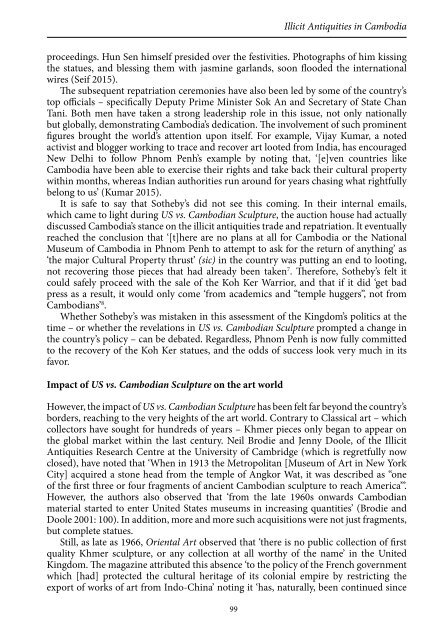Countering
Book_observatory_illicit_traffic_version%20issuu
Book_observatory_illicit_traffic_version%20issuu
You also want an ePaper? Increase the reach of your titles
YUMPU automatically turns print PDFs into web optimized ePapers that Google loves.
Tess Davis<br />
independence by the Cambodian government’. In conclusion, it lamented that ‘for those<br />
of us who are not privileged to travel to Paris or Phnom-Penh, our only experience of<br />
Khmer sculpture for some time to come will be through the medium of books’ (Lowry<br />
1966).<br />
This fear was unfounded. As the story of the Koh Ker Warriors makes clear, Cambodia<br />
meted out its heritage starting with the 1970 Civil War. But even in the subsequent<br />
decades, as the art world began to improve its practices – at least with regards to suspect<br />
classical, Near, and Middle Eastern antiquities – ‘Asian collections […] rarely figured<br />
into the debate’ (Broodie and Doole 2001: 84). In 2004, Brodie and Doole observed that,<br />
‘[m]ost Asian objects that appear on the market do so seemingly out of thin air […]<br />
hardly ever accompanied by any details of find circumstances or previous ownership’<br />
(Brodie and Doole 2001: 100).<br />
They were not the only experts troubled by this double standard. In 2008, in a New<br />
York Times op-ed piece, critic Souren Melikian lamented how ‘art casualties from Tibet to<br />
Cambodia’ still found ‘an eager market’ in the United States. With regards to a Sotheby’s<br />
auction of Asian antiquities, he pondered ‘how it is that so few questions are asked about<br />
just how works of art of major importance, for which no government would ever issue an<br />
export license, come to tumble on to the market. Do the temples of Cambodia, erected<br />
by the Khmers at the height of their culture between the 10 th and 13 th centuries, ring<br />
so few bells?’ Melikian concluded his scathing argument with begrudging resignation:<br />
‘From Tibet to Cambodia, the common treasure of mankind is squandered at a rate that<br />
matches that of melting Antarctica. And business goes on’ (Melikian 2008).<br />
However, just five years later in 2012, business most assuredly did not ‘go on’ for<br />
Sotheby’s, at least with regards to the Koh Ker Warrior. The auction house itself seemed<br />
caught off guard by the sudden change in circumstances, publically stating in the wake<br />
of US vs. Cambodian Sculpture, ‘we are disappointed that this action has been filed and<br />
we intend to defend it vigorously’ (Blumenthal and Mashberg 2012). The company’s<br />
Vice President had earlier insisted that ‘Sotheby’s approach to the Khmer sculpture is<br />
one of responsible and ethical market behavior and international cooperation between<br />
private and public entities’ (Blumenthal and Mashberg 2012). But just as Mr. Melikian<br />
had disagreed, so too did other experts vehemently disagree with lawyer and professor<br />
Herbert Larson who told the Times: ‘Every red flag on the planet should have gone off<br />
when this was offered for sale. It screams “loot”’ (Blumenthal and Mashberg 2012).<br />
Sotheby’s – publically at least – appeared confident of winning the case up until the<br />
signing of the settlement. Nor did the auction house completely abandon this position<br />
in that agreement, in which it insisted that ‘Sotheby’s and its client acted properly at<br />
all times.’ (Blumenthal and Mashberg 2013). Regardless, US vs. Cambodian Sculpture<br />
has made clear that the federal government strongly believes that Cambodia has a valid<br />
legal claim under American law to its stolen antiquities, even those that have been in<br />
overseas collections for decades. The Department of Justice has moreover proved itself<br />
very willing to back that belief with litigation on Cambodia’s behalf.<br />
While Sotheby’s may have been willing accepted to take on the full brunt of<br />
Washington, other institutions have apparently judged one antiquity not worth the<br />
risk. Again, with the exception of the Warrior, all the other returns thus far have been<br />
voluntarily – including those from the Metropolitan Museum of Modern Art, Norton<br />
Simon, and Cleveland Museums, as well as Sotheby’s main rival, Christie’s Auction<br />
House.<br />
There is also some indication that even Sotheby’s, or at the very least its customers,<br />
100


